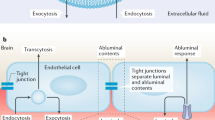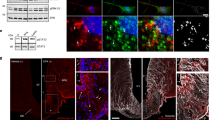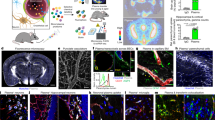Abstract
OBJECTIVE: Peripherally administered exendin-4 is in clinical trials for the treatment of diabetes mellitus and obesity. Since its effects on food intake are mediated centrally, we determined the degree and type of its blood-to-brain penetration of the mouse blood–brain barrier (BBB).
MEASUREMENTS AND RESULTS: High-performance liquid chromatography showed that exendin-4 was stable in blood, with most of the injected peptide reaching the brain intact. Capillary depletion studies with washout showed that the injected exendin-4 reached brain parenchyma rather than being trapped in the endothelial cells composing the BBB. Multiple-time regression analysis showed that exendin-4 crossed the BBB directly at a fast rate. The rapid brain entry of exendin-4, helped by its high lipophilicity as demonstrated by the octanol/buffer partition coefficient, was not dependent upon circumventricular organs and was not affected by food deprivation for 24 h. The simultaneous i.v. injection of high doses of unlabeled exendin-4 resulted in self-inhibition (saturation) that only became statistically significant (P<0.05) when the results of four experiments were combined; this suggests a possible limit to the amount of peripherally administered exendin-4 that can reach the brain after injection of high doses.
CONCLUSION: The results indicate that exendin-4 is well conformed for exerting central effects involved in the control of obesity.
This is a preview of subscription content, access via your institution
Access options
Subscribe to this journal
Receive 12 print issues and online access
$259.00 per year
only $21.58 per issue
Buy this article
- Purchase on Springer Link
- Instant access to full article PDF
Prices may be subject to local taxes which are calculated during checkout





Similar content being viewed by others
References
Kieffer TJ, McIntosh CHS, Pederson RA . Degradation of glucose-dependent insulinotropic polypeptide and truncated glucagon-like peptide 1 in vitro and in vivo by dipeptidy1 peptidase IV. Endocrinology 1995; 136: 3585–3596.
Young AA, Gedulin BR, Bhavsar S, Bodkin N, Jodka C, Hansen B, Denaro M . Glucose-lowering and insulin-sensitizing actions of exendin-4: studies in obese diabetic (Ob/Ob, Db/Db) mice, diabetic fatty zucker rats and diabetic rhesus monkeys (Macaca mulatta). Diabetes 1999; 48: 1026–1034.
Rodriquez de Fonseca F, Navarro M, Alvarez E, Roncero I, Chowen JA, Maestre O, Gomez R, Mundoz RM, Eng J, Blazquez E . Peripheral versus central effects of glucagon-like peptide-1 receptor agonists on satiety and body weight loss in zucker obese rats. Metabolism 2000; 49: 709–717.
Goke R, Larsen PJ, Mikkelsen JD, Sheikh SP . Distribution of GLP-1 binding sites in the rat brain: evidence that exendin-4 is a ligand of brain GLP-1 binding sites. Eur J Neurosci 1995; 7: 2294–2300.
Banks WA, Kastin AJ . Opposite direction of transport across the blood–brain barrier for Tyr-MIF-1 and MIF-1: comparison with morphine. Peptides 1994; 15: 23–29.
Kastin AJ, Akerstrom V, Pan W . Validity of multiple-time regression analysis in measurement of tritiated and iodinated leptin crossing the blood-brain barrier: meaningful controls. Peptides 2001; 22: 2127–2136.
Banks WA, Kastin AJ . Measurement of transport of cytokines across the blood–brain barrier. In: Conn PM, De Souza EB (eds). Neurobiology of cytokines, Part A. Academic Press Inc.: San Diego; 1993. pp 67–77.
Banks WA, Fasold MB, Kastin AJ . Measurement of efflux rates from brain to blood. In: Irvine GB, Williams CH (eds). Methods in molecular biology, neuropeptide protocols, Vol. 73. Humana Press Inc.: Totowa, NJ; 1997. pp 353–360.
Burton PS, Conradi RA, Hilgers AR, Ho NFH, Maggiora LL . The relationship between peptide structure and transport across epithelial cell monolayers. J Control Rel 1992; 19: 87–98.
Burton PS, Conradi RA, Hilgers AR . Mechanisms of peptide and protein absorption, (2) transcellular mechanism of peptide and protein absorption: passive aspects. Adv Drug Deliv Rev 1991; 7: 365–386.
Kastin AJ, Akerstrom V, Hackler L . Food deprivation decreases blood galanin-like peptide and its rapid entry into the brain. Neuroendocrinology 2001; 74: 423–432.
Kastin AJ, Akerstrom V . Fasting, but not adrenalectomy, reduces transport of leptin into the brain. Peptides 2000; 21: 679–682.
Kastin AJ, Wade LA, Coy DH, Schally AV, Olson RD . Peptides and the blood–brain barrier. In: Wuttke W, Weindl A, Voigt KH, Dries RR (eds). Brain and pituitary peptides. Karger: Munich; 1980. pp 71–78.
Ritzel U, Leonhardt U, Ottleben M, Ruhmann A, Eckart K, Spiess J, Ramadori G . A synthetic glucagon-like peptide-1 analog with improved plasma stability. J Endocrinol 1998; 159: 93–102.
Kastin AJ, Akerstrom V, Pan W . Interactions of glucagon-like peptide-1 (GLP-1) With the blood–brain barrier. J Molec Neurosci 2002; 18: 7–14.
Kastin AJ, Akerstrom V, Hackler L, Pan W . Adrenomedullin and the blood–brain barrier. Hormones Metab Res 2001; 33: 19–25.
Kastin AJ, Akerstrom V, Hackler L . Agouti-related protein (83–132) aggregates and crosses the blood–brain barrier slowly. Metabolism 2000; 49: 1444–1448.
Kastin AJ, Akerstrom V . Entry of CART into brain is rapid but not inhibited by excess CART or leptin. Am J Physiol 1999; 277: E901–E904.
Banks WA, Jaspan JB, Kastin AJ . Effect of diabetes mellitus on the permeability of the blood–brain barrier to insulin. Peptides 1997; 18: 1577–1584.
Kastin AJ, Akerstrom V . Mahogany (1377–1428) enters brain by a saturable transport system. J Pharmacol Exp Ther 2000; 294: 633–636.
Kastin AJ, Akerstrom V . Nonsaturable entry of neuropeptide Y into the brain. Am J Physiol 1999; 276: E479–E482.
Kastin AJ, Akerstrom V, Hackler L, Zadina JE . Phe13,Tyr19-melanin-concentrating hormone and the blood-brain barrier: role of protein binding. J Neurochem 2000; 74: 385–391.
Kastin AJ, Akerstrom V, Pan W . Activation of urocortin transport into brain by leptin. Peptides 2000; 21: 1811–1818.
Kastin AJ, Akerstrom V . Orexin A but not orexin B rapidly enters brain from blood by simple diffusion. J Pharmacol Exp Ther 1999; 289: 219–223.
Banks WA, Kastin AJ, Akerstrom V, Jaspan JB . Radioactively iodinated cyclo(His-Pro) crosses the blood–brain barrier and reverses ethanol-induced narcosis. Am J Physiol 1993; 267: E723–E729.
Chikhale EG, Burton PS, Borchardt RT . The effect of verapamil on the transport of peptides across the blood–brain barrier in rats: kinetic evidence for an apically polarized efflux mechanism. J Pharmacol Exp Ther 1995; 273: 298–303.
Banks WA, Kastin AJ . Differential permeability of the blood–brain barrier to two pancreatic peptides: insulin and amylin. Peptides 1998; 19: 883–889.
Banks WA, Jaspan JB, Huang W, Kastin AJ . Transport of insulin across the blood–brain barrier: saturability at euglycemic doses of insulin. Peptides 1997; 18: 1423–1429.
Banks WA, Kastin AJ, Huang W, Jaspan JB, Maness LM . Leptin enters the brain by a saturable system independent of insulin. Peptides 1996; 17: 305–311.
Acknowledgements
Supported by NIH (DK 54880) and the Department of Veterans Affairs.
Author information
Authors and Affiliations
Rights and permissions
About this article
Cite this article
Kastin, A., Akerstrom, V. Entry of exendin-4 into brain is rapid but may be limited at high doses. Int J Obes 27, 313–318 (2003). https://doi.org/10.1038/sj.ijo.0802206
Received:
Revised:
Accepted:
Published:
Issue Date:
DOI: https://doi.org/10.1038/sj.ijo.0802206
Keywords
This article is cited by
-
Sitagliptin elevates plasma and CSF incretin levels following oral administration to nonhuman primates: relevance for neurodegenerative disorders
GeroScience (2024)
-
Exendin-4 ameliorates tau hyperphosphorylation and cognitive impairment in type 2 diabetes through acting on Wnt/β-catenin/NeuroD1 pathway
Molecular Medicine (2023)
-
Incretin and insulin signaling as novel therapeutic targets for Alzheimer’s and Parkinson’s disease
Molecular Psychiatry (2023)
-
New insights toward molecular and nanotechnological approaches to antidiabetic agents for Alzheimer’s disease
Molecular and Cellular Biochemistry (2023)
-
Activation of glucagon-like peptide-1 receptors reduces the acquisition of aggression-like behaviors in male mice
Translational Psychiatry (2022)



